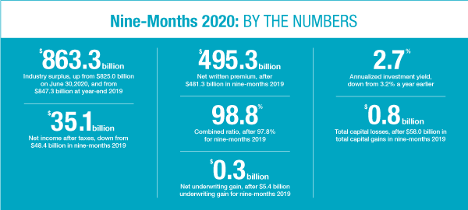In the first nine months of 2020, net income for the U.S. property/casualty insurance industry dropped 27.5% to $35.1 billion and net underwriting gains declined to $0.3 billion, from $5.4 billion a year earlier as the industry dealt with the effects of the COVID-19 pandemic and an historic catastrophe season.
According to a report from data firm Verisk and the American Property Casualty Insurance Association (APCIA), the deterioration in underwriting results was due, in part, to the losses and loss adjustment expenses from catastrophes, which more than doubled to $47.1 billion for nine-months 2020 from $21.5 billion in the same nine-month period a year earlier.
Verisk’s PCS reported that 2020 set a record for the number of U.S. catastrophic events. The 2020 catastrophes included 19 events with at least $1 billion in direct insured losses in the United States (17 in the first nine months), including the first riot and civil disorder event to exceed that threshold.
The U.S. also recorded one of the largest deteriorations on the Verisk Maplecroft Civil Unrest Index over the past year—increasing from the 91st riskiest jurisdiction by the second quarter of 2020 to the 34th. The index assesses the risk of disruption to business caused by civil unrest and includes a spectrum of incidents, from protests to violent mass demonstrations and rioting.
Auto Insurers
Auto insurers benefited from the reduced driving activity due to the pandemic during the first nine months of 2020, with the pure loss ratio for auto insurance improving to 56.6% from 65% compared to the same period in the previous year. Many auto insurers provided partial premium refunds to current policyholders and adjusted their rates. Verisk’s ISO estimates that insurers provided approximately $11 billion in direct premium refunds and renewal credits to policyholders.
According to Verisk, the effect of prospective rate changes driven in part by COVID-19 can’t be reliably estimated.

Policyholders’ surplus rose $16 billion to $863.3 billion as of Sept. 30, 2020, from $847.3 billion as of Dec. 31, 2019, driven by growth in the stock market.
The report said that while it might take time before the insured losses directly attributable to pandemic can be reliably estimated, the impact on premiums was immediate. Due to the economic disruption, consumers and businesses deferred and canceled large purchases and capital investments, which led to reduced premium activity. The written direct premium growth slowed to 2.3% for the first nine months of 2020 compared to 4.8% in the same time period in 2019.
Robert Gordon, APCIA senior vice president, policy, research and international, said analysts expect commercial lines insurers to face significant reductions in premiums due to audits that reflect reduced revenues and payrolls.
“The industry continues to face the strong headwinds of unknown but potentially severe future COVID-19 related losses and long-term claims,” Gordon said.
The COVID-19 vaccines should help the economic recovery going forward but many questions remain.
“The beginning of COVID-19 vaccination efforts has provided some hope for people in the United States and across the globe,” said Neil Spector, president of ISO at Verisk. “But the U.S. economy and the insurance industry still face many challenges which will depend on our progress in ending the pandemic.”
“How long will it take to vaccinate the majority of the population? What impact will new strains of the disease have on its spread? How will businesses that require large in-person crowds continue to survive? Which of the pandemic-driven changes are here to stay? All of these questions will have a major impact on the types of insurance and service that customers expect,” Spector added.
Third-Quarter Results
After taxes, insurers’ net income fell to $10.9 billion in third-quarter 2020 from $15.4 billion in third-quarter 2019, and their combined ratio deteriorated to 101.3% in third-quarter 2020 from 98.8% in the same period a year earlier.
Net written premiums rose $5.0 billion, or 3.0%, to $171.3 billion in third-quarter 2020 from $166.2 billion in third-quarter 2019. Net earned premiums grew 2.3% to $162.9 billion in third-quarter 2020 from $159.2 billion from the third quarter a year earlier.
Results from insurers reporting thus far on their fourth quarter performances — including Travelers, Chubb, Allstate, The Hartford and W.R. Berkley— suggest the P/C industry may finish the year strong.
Related:
Was this article valuable?
Here are more articles you may enjoy.


 Aon Completes $13B Acquisition of Middle-Market Broker NFP
Aon Completes $13B Acquisition of Middle-Market Broker NFP  Marsh McLennan Agency to Buy Fisher Brown Bottrell for About $316M
Marsh McLennan Agency to Buy Fisher Brown Bottrell for About $316M  Chubb Wins Latest Battle With New York Diocese in Bid to Avoid Sex Abuse Claims
Chubb Wins Latest Battle With New York Diocese in Bid to Avoid Sex Abuse Claims  Why New York’s Attorney General Objects to Trump’s Bond Insurer
Why New York’s Attorney General Objects to Trump’s Bond Insurer 

